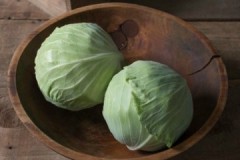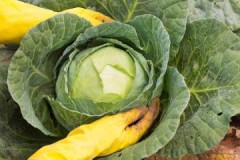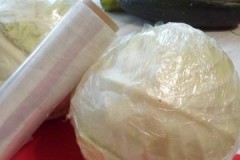Useful information: when should you store cabbage for the winter?
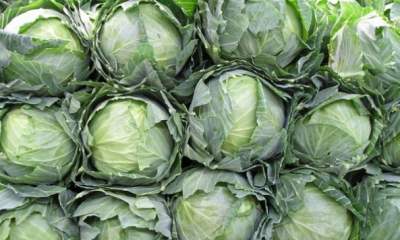 It is not enough to grow a rich crop, it is very important to know when and how to harvest cabbage in order to preserve its nutritious flavor as long as possible.
It is not enough to grow a rich crop, it is very important to know when and how to harvest cabbage in order to preserve its nutritious flavor as long as possible.
In this article, we will tell you when it is necessary and possible to remove cabbage from the garden for storage for the winter, at what temperature it is better to start picking a vegetable.
Content
When is it necessary and possible to collect heads of cabbage in the garden, at what temperature?
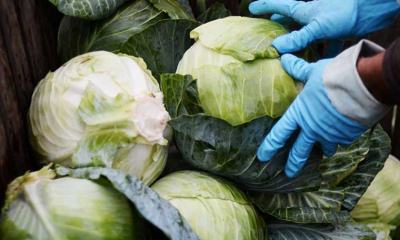 To determine that the head of cabbage is ripe and it's time to cut it off, simply:
To determine that the head of cabbage is ripe and it's time to cut it off, simply:
- when the forks are squeezed, it emits a characteristic crunch,
- the leaves have acquired a bluish tint,
- the top of the head of cabbage has become smooth and shiny.
When planning a harvest, in addition to external signs of maturity, it is necessary to pay attention to weather conditions.
Perfect weather to cut heads cabbage:
- without precipitation,
- slightly cloudy,
- air temperature from +4 to + 8 ° С.
Depending on the ripening period
The harvesting time of cabbage largely depends on the ripening time of each particular variety.
- Early varieties (for example June) harvested on the ninetieth day after disembarkation of seedlings (starting at the end of June). Early varieties cannot be kept in the garden for a long time, since the heads of cabbage overripe, begin to crack and rot.
- Mid-season varieties (for example, Slava or Kupchikha) stored for up to five months. Harvesting begins in September (one hundred and forty days after planting the seeds).
- Late, or winter, varieties (for example, Creumont or Amager) - the best option for long-term storage. The collection of these small, dense heads of cabbage begins one hundred and fifty days after disembarkation of seedlings (in mid-October). If the necessary conditions are met, later varieties of cabbage can be stored for up to nine months.
As practice has shown, those varieties that are harvested in August - October are best stored. Long-term storage is facilitated by the rather dense structure of the head, the minimum amount of liquid in the leaves and the late harvest.
We take into account the climate and region
One of the determining factors for the harvest date of cabbage is the climate of the region in which it was grown:
-
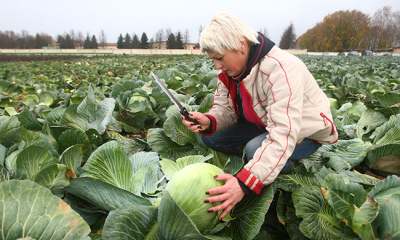 In outskirts of Moscow the cabbage is harvested in the second half of September. The end of the harvest is the last weeks of October.
In outskirts of Moscow the cabbage is harvested in the second half of September. The end of the harvest is the last weeks of October.The harvested crop must be immediately lowered into a chilled storage. Otherwise, there are great risks that the heads of cabbage will begin to rot.
- In the harsh conditions of Siberia harvesting cabbage begins in the first week of September (it is during this period that the air temperature reaches zero).
If during the harvesting process the air temperature dropped to -4 ° C, that's okay. You can continue to work, provided that the head of cabbage has thawed at the root.
- In the Urals picking cabbage begins in early September. To determine a more accurate date, experienced gardeners are advised to count four months from the date of planting seedlings in open ground.
How to remove from the garden correctly?
It is possible to preserve the integrity of the cabbage head, and at the same time ensure the longest possible storage period for the crop, subject to certain collection rules:
- Heads of cabbage are cut only in dry weather. Wet leaves very quickly begin to rot, because if it rains during the harvest, before storing the cabbage, it must be thoroughly dried outside under a canopy.
- Ten days before the start of harvesting, watering the beds with cabbage is stopped.
- Heads of cabbage are cut with a hatchet or cut with a very sharp knife. You will need a sharp pitchfork to dig in the roots. It is important during the cutting process to ensure that the length of the stump remains at least 5 cm.
- If the soil in the garden is loose, the heads of cabbage are twisted together with the roots.
- When cutting the cabbage, be sure to leave three integumentary leaves. It is they who will protect the head from damage, damage by rot, fungi and mold.
- Insufficiently formed, rotten and other “defective” heads of cabbage are immediately sorted out and deposited. They are not suitable for long-term storage.
Features for different types of vegetables
The beginning of the harvest depends largely on the variety of cabbage grown.
Savoy
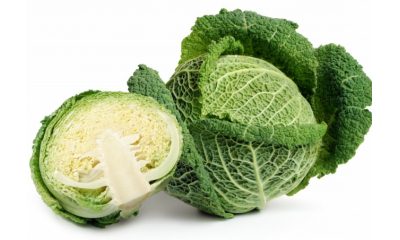 This variety has very delicate corrugated leaves.... The early variety is ready for harvest sixtieth day after sowing the seed.
This variety has very delicate corrugated leaves.... The early variety is ready for harvest sixtieth day after sowing the seed.
Late varieties can be harvested three months after planting (they tolerate the first frosts well).
The main sign of maturity is an elastic, dense head of cabbage (weight 2-3 kg)... Heads of cabbage are cut off in dry weather, trying to leave the stump as long as possible. When laying for storage, two or three wrapper leaves are left on the head of cabbage.
Colored
It is very easy to choose the moment of harvesting the cauliflower, just see if the head is ripe. The following signs indicate ripeness:
- the head is solid, white;
- there is no flowering (small green leaves);
- the stump reaches up to 8 cm in diameter.
Dig the heads of cabbage together with the cabbage stumps. When storing, the top leaves and roots are removed from the cauliflower.
Redhead
Harvested in the last week of September - early October... For long-term storage, select only elastic heads of cabbage, bright purple color.
After the heads of cabbage are cut, they are left to dry for some time in the fresh air, after which they are lowered for long-term storage in the basement.
Broccoli
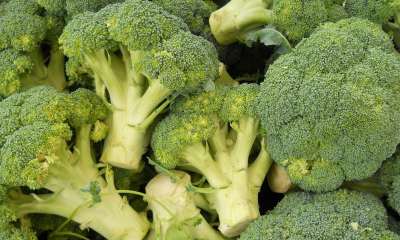 The harvest begins 70-100 days after the germination of the seed (depending on the region, the collection time falls on the last days of August - early September).
The harvest begins 70-100 days after the germination of the seed (depending on the region, the collection time falls on the last days of August - early September).
Heads of cabbage are cut in dry, cool weather, in the morning or evening hours (the sun negatively affects the nutritional properties of broccoli).
It is very important to ensure that the broccoli heads do not freeze... One night with subzero temperatures and cabbage left in the garden will lose its taste and nutritional properties.
Beijing
Depending on the variety, harvesting can begin on the sixtieth day of seed germination (mid-season varieties) or on the eightieth day (late-season varieties). As a rule, by mid-October the harvest of Peking cabbage is fully harvested.
How to prepare your harvest?
Preparing cabbage for storage boils down to three stages:
- Choosing the best heads of cabbage... For long-term storage, only strong, dense heads are left. It is important to watch that the leaves are not eaten by butterflies or slugs, there are no cracks on the stump. Unripe cabbage heads, heads of cabbage with mechanical damage obtained during harvesting are not subject to storage.
- Cut off excess... Before sending the head of cabbage for storage, the upper leaves are plucked from it (no more than three protective leaves are left), the leg is cut off.
- We wash, dry... Heads of cabbage are washed from the ground with a stream of cool water, after which the cabbage is dried in the fresh air.
Where is the best place?
There are plenty of places to store cut cabbages:
- Basement or cellar - an ideal place with optimal storage conditions for the harvested crop. Before laying, the heads of cabbage are dried and wrapped in several layers of newsprint. It is convenient to store cabbage in the basement hanging. To do this, the heads of cabbage are tied in pairs and hung on the crossbar.
-
 Pantry - a good place for storage, provided that the required air temperature level (from 0 to + 3 ° С) is maintained in it.
Pantry - a good place for storage, provided that the required air temperature level (from 0 to + 3 ° С) is maintained in it.Before storing food, make sure that the walls of the pantry are free of mold. Heads of cabbage are wrapped in parchment and laid out in a pyramid (stumps up) in the darkest corner.
- Balcony suitable for storing cabbage only if it is insulated and in winter the air temperature in the room does not drop below -4 ° C. Heads of cabbage are laid out in lattice wooden or plastic boxes with stumps inside.
- In fridge... A small harvest of cabbage can be stored in a regular refrigerator. Each head of cabbage is wrapped with cling film and placed in the vegetable compartment. The cabbage is periodically checked for foci of rot and mold.
Advice
It is important to adhere to the following recommendations:
- Do not leave cut heads of cabbage in the garden at sub-zero temperatures. The cabbage will freeze, after thawing it will lose its taste and spoil very quickly.
- If during the harvesting period the air temperature drops below 0 ° C, the still uncut heads should be left in the garden. You can cut them when the air warms up and the forks thaws.
- Do not delay the cabbage harvest. At a temperature of -6 ° C, the heads of cabbage freeze, which leads to rapid deterioration of the product.
- So that the cut heads do not lose their juiciness during storage, a few protective leaves are left on them.
- When laying cabbage for storage in a basement or cellar, you need to make sure that there are no boxes with vegetables or fruits with a pungent smell in the neighborhood.
- Stocks should be checked periodically for rotten heads. Otherwise, one rotten vegetable can spoil almost the entire crop.
He will tell you about the temperature at which fresh cabbage should be stored in winter this article. Read the most important information about storing cabbage. here.
Related videos
How and when to harvest cabbage, the video will tell you:
Conclusion
Having studied the recommendations of the correct collection of cabbage in advance, you can preserve its nutritional and taste value for as long as possible.

